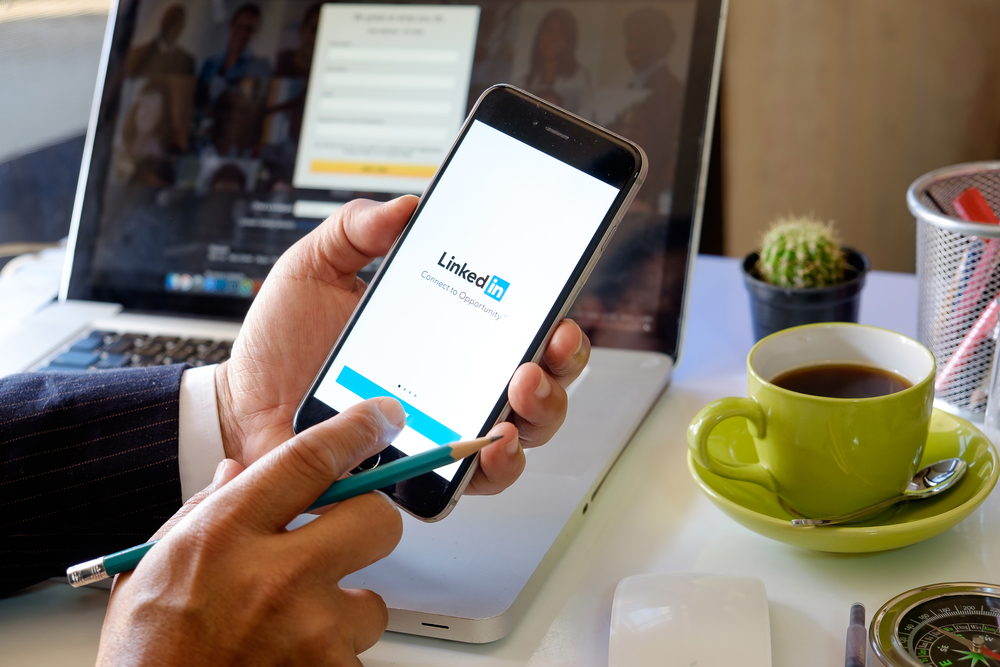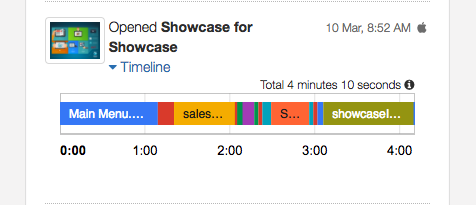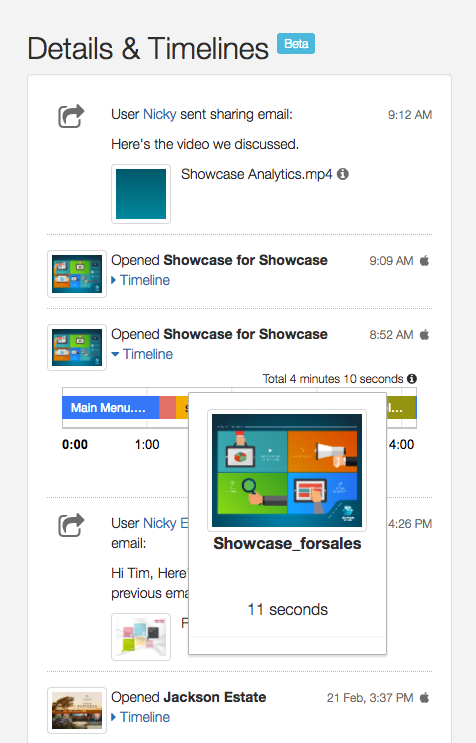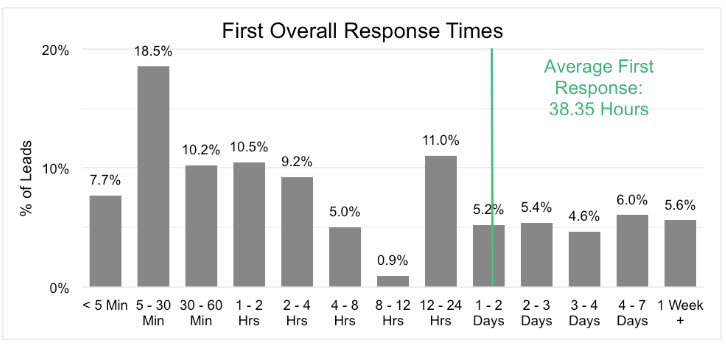You can order your latte before you leave the house.
You can reconnect with your high-school sweetheart without picking up the phone.
You can even use an app to try on clothes before you buy them.
Technology has allowed us to become faster and more efficient. We’re multitasking machines. This productivity has come at a cost, though …
We’ve lost human connection.

We willingly live so much of our lives behind screens, but our desire for human connection hasn’t gone anywhere.
Even with the increasing disconnection, we still prefer to buy from people we like. Especially, people, we feel we have a personal connection with.
This is the secret of the best salespeople:
Making a personal connection with our customers, showing that we genuinely care about them, helps us stand out in their minds — and stand out from the competition.
What if, instead of using technology to keep people at arm’s length, we used it to strengthen personal connection?
There are a million articles online telling salespeople how to court customers, how to pitch solutions, and how quickly and frequently reps should be following up. Few resources, however, talk about how the very technology we salespeople use to do our jobs can contribute to the relationships we build with our customers.
Technology improves our efficiency and extends our reach, but it can also help us connect in personal, meaningful ways.
Meeting customers in person and speaking with them on the phone are still two of the most powerful methods of growing relationships with customers — and they can be enhanced with the right technology.
We can make sales a personal experience for our customers again.
In this article, I’m going to share three ways I combine personal connection and technology to build better relationships with my customers.
1. Remove Friction from the Sales Process
Sandpaper on your skin, skidding tires, arguing with your significant other …
Friction of any kind doesn’t feel nice. Amiright?!
In business, friction is the level of difficulty customers have in doing business with our companies.
Some friction is inevitable, no matter how streamlined our processes are. Humans are fallible, miscommunications happen and systems sometimes fail. The good news is, with a few small changes in your sales process, you can smooth out some of that friction and make buying a better experience for your customers.
Smooth the path from hello to sale
An usher at a grand theatre noticed a cowboy sprawled across three seats near the stage. "Sorry, sir, but you're only allowed one seat," the usher said to the cowboy.
The cowboy didn’t move.
Annoyed, the usher repeated, "Sir, you’re only allowed one seat. If you don't get up, I'm going to call the manager."
The cowboy didn’t move.
The usher brought the manager over. “Sir, you’re only allowed one seat. We have asked you repeatedly to get up. You need to leave this theatre at once.”
The cowboy didn’t move.
The usher and the manager called the police. When the policeman arrived, he assessed the situation and approached the seat-hogging cowboy. "What's your name?" asked the policeman.
“Sam,” the cowboy grunted.
“Where are you from, Sam?" asked the policeman.
"The balcony," groaned the cowboy.

While I'm pretty much a sucker for any good cowboy story, the moral of course is: Don’t make assumptions about people.
Yet we do exactly that when we don’t take the time to get to know our customers.
If you wait to establish a relationship until a prospect is ready to buy, you’ve waited too long. A relationship doesn’t ask anything of the other person except to connect on a human level.
So start building that relationship as far ahead of the sale as you can.
Research your prospects before you reach out to them. I don't mean just find them on Facebook and attempt to use lame small talk about something you're pretending to have in common with them.
Use the power of the internet to figure out what their problems and preferences are and build a connection with them from there.
Don’t leave the follow-up to the buyer
Your customers have enough on their plates. Don’t make them responsible for tracking you down when they are ready to buy.
Even seasoned sales reps make the mistake of leaving the conversation open-ended. But there’s an easy fix. If you get the sense that the prospect is interested in moving forward, take the initiative and get agreement on what the next step will be.
- Tell them you’ll give them a follow-up call, and ask when a good day and time would be.
- Find out when they plan to make their decision, and offer to call them after that date.
- Let them know you’ll be sending over content / a slide deck / a proposal for them to look over, and ask how much time they’d like to have before you call to discuss it.
Especially when it comes to proposals, don’t just send the document and then chew your nails while you wait for a response. Tell the prospect when they can expect your proposal, then set a day and time to discuss that proposal.
Luckily, you have technology on your side with all of this. If you’re using an app like Showcase to send content and files, you’ll be able to tell when the prospect opened your message and if they downloaded the content.
Which leads me to my next point …
Make the experience of viewing sales content totally frictionless
Sharing content with your customers and prospects is one of the things you have complete control over. You can make it totally painless for the recipient. Better yet, with the right tool, you can make it impressive.
Most file-sharing tools add unnecessary friction to the process of sending, receiving and viewing files —
- If you use email, you're at the mercy of spam filters capturing the email
- If you use most popular file-sharing software, your buyer has to create an account in order to view the files you send them
- If you use a document management system like Google Drive, file security is tricky, and your customer may not have the right permissions to view a document.
We struggled with this, too. And this is exactly why we designed Showcase sharing the way we did. With the Showcase app, you can share files securely from any mobile device. Your customer receives an email with a link to the file, and they can open it without any special permissions and without an account.
Technology should enable the sale. If your tools are adding friction to the buying process, or they’re making relationship-building more challenging than it should be, it’s time to assess your software.
In the past three years, more than 80% of companies have changed at least one business process to better interact with customers — including increased investment in sales technology. (Source: Avanade Global Survey: B2B is the New B2C)
2. Use Data to Personalise the Interaction
“Some people use research like a drunkard uses a lamppost: for support, not illumination.” –David Ogilvy
I touched on this in the last section, but it deserves much more attention:
Learn all you can about your prospect before you attempt to contact them.
So many salespeople have this backward. They start by reaching out to a prospect to get a sense for their level of interest in the product or service. Only if there is interest do they make the effort to learn more about the prospect — and at this point, the salesperson is focused only on making the sale. Relationship is a means to an end. It’s not authentic.
There are a few reasons why this is unhelpful:
- The relationship between a sales rep and a buyer must be authentic to be beneficial.
- Customers smell a sales ploy from a mile away.
- Sales reps waste a lot of time talking to people who will never buy from them.
Business development consultant Wayne O’Neill of RESET believes that the most powerful way for B2B salespeople to increase their sales is to focus on deeply understanding a prospect’s business and political issues. These are the five issues that every customer is concerned with, that impact them every single day: competitors, customers, staff, stakeholders and business model. If you’re selling direct to consumers, those five items may look a bit different, but the effect is the same. Focus on understanding the issues that impact your customer every single day, so you can help them solve those problems and improve their lives.
“The best salespeople understand their best clients inside and out.” – Mike Michalowicz, author of Profit First
How do you do this? Go beyond what you see in your CRM.
- Spend time on the company website.
- Look at the customer’s social media profiles, including LinkedIn, Facebook and Twitter. Read their bio, but also read the messages they’re posting and the comments they’re making.
- Look at the purchasing history of other customers within the company if you can.
- If possible, talk to someone who knows them.
And do this before you ever pick up the phone.
Your customer will be a lot more likely to hear you out (or return your call) when you seem to know who they are.

This is just the beginning, however. Once you have initiated the customer relationship, it’s time to start sharing helpful content with them. But there’s another important step to take after you do this, too. This step is what separates the sales leaders from the average performers …
Monitor and analyse how the prospect interacts with your content
If you’re sending files via email and using read receipts to get notified when the recipient opens your email, you might think you’re already doing this. But trust me when I say there’s a whole other world of analytics at your fingertips today.
When you send content to a customer, there are actually three things to monitor:
- Receipt: Did they open your email?
- Download: Did they open the file?
- Viewing: Did they read through the file?
When you track all three of these things, you know exactly how your customer is interacting with your content — and that insight informs your next step. Did they open the brochure, but didn’t read through it? Maybe they don’t understand how the solution can solve their problem, and a demo is in order. Did they return to the slide deck several times, and spend a good amount of time on it? Your customer might be ready to buy. Time to check in!


Your standard email read receipt alerts you to when a customer opens your email. Most of the time, at least. Remember, your customer can probably set up their email program to deny the sending of read receipts, so they’re not 100% reliable.
But to monitor the other two things — downloads and reading time — you’ll need more than standard email software.
Once again, many popular document-sharing systems can handle some of this monitoring … but they won’t track all of it. And they won’t track it in detail. Use a tool like Showcase that keeps track of opens, downloads and time spent looking at the content, reliably and all in one place.
3. Establish Your (Responsive) Expertise
This is going to knock your socks off and maybe break your heart a little bit …
- Companies take an average of 38.35 hours to respond to leads.
- In this recent InsideSales study, the company submitted leads to 4,723 companies’ web forms, and 50% never received any personalized response of any kind, while 77.17% of those leads were never called.
- 49% of reps ignore more than half of all leads provided by marketing.
Yet leads responded to within 5 minutes are 100 times more likely to be reached and 21 times more likely to be qualified.

(Source: InsideSales.com)
What does this have to do with making sales a personal experience for your customers?
These statistics suggest that your customers find your responsiveness as important as your expertise. If they are able to reach you when they need you, you’re more likely to make the sale. However, if you’re not on the ball — if you’re not responsive when a customer reaches out to you — it affects your relationship now and into the future.
Reliability and trustworthiness go hand-in-hand. Your expert knowledge and role as a customer’s go-to resource are only as good as your dependability when your customer needs help.
Once again, the right technology makes this easy to do … from anywhere.
A lot of the salespeople we work with spend much of their time in the field. They meet customers face-to-face, sometimes in remote locations — and because of this, follow-up was a big challenge. By the time the sales rep made it back to his desk, he’d forget that the customer requested more information about a certain product. Or, if he did manage to remember, by the time he sent the content the client requested, the client’s interest had waned.
Thanks to technology, however, now you don’t have to wait until you get back to your desk to send content to an interested buyer. You can respond immediately to customer requests during sales conversations.
Eliminating any delay in your response time in this way has two important benefits:
- It immediately establishes with the customer that you are responsive and reliable, increasing that all-important trust factor.
- It increases your credibility as an expert.
So choose a tool that makes it easy to find and send content from any device, in any location. Your reputation will reap the benefits!
Consider your content collection a sales portfolio
Portfolios are not limited to the world of visual arts. Many professional experts display their expertise in similar ways.
Think about an architect’s portfolio. Or a builder’s portfolio. These collections of work are visually displayed, usually there is a digital version of them, and the complete portfolio may or may not be on the company website.
How are you displaying your company’s products and services? Does your process showcase your expertise, like a tidy digital portfolio? Or does it scream “out of date” like a printed brochure (that you may or may not have left back at the office)?
Here are a few things to look for when you’re choosing software to display your work:
- Professional-looking visuals
- Easy navigation
- Can handle multiple file types (like images, PDFs and videos)
- Offers complete control over permissions and access
- Includes analytics so you know what content is most popular
Finally …
Show your customer that you’re a forward-thinker
If you’ve been in sales for a while, you’ve seen a lot of changes. Digitization of the sales process is one of the biggest changes that’s happened in the last 20 years.
Today’s buyers expect vendors to be up-to-date on the digital world. They want to make payments online, find information from their smartphones, and communicate virtually. Sticking to old-school sales processes and stodgy systems paints you and your company as irrelevant. Especially if you pride yourself on innovation and forward-thinking, every aspect of your sales process needs to be convenient for the customer.
This all starts, of course, with delivering your message.

You’re Not a Vending Machine
You’re human. Your customers are human. Connect on a human level … and use technology to facilitate that.
Instead of cobbling together solutions with string and chewing gum, choose tools that do everything you need them to do. For sales enablement, Showcase is the sleekest, most convenient solution around. Grab your sales manager and schedule a Showcase demo today to see how easy it is to use content to connect with your customers — wherever and whenever.